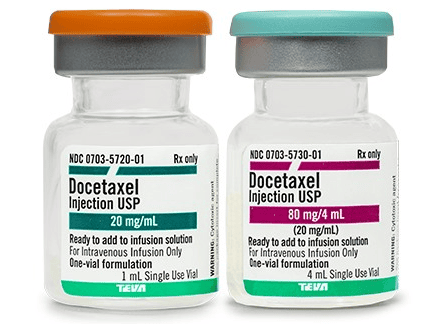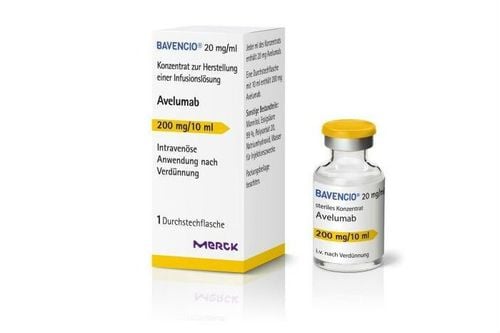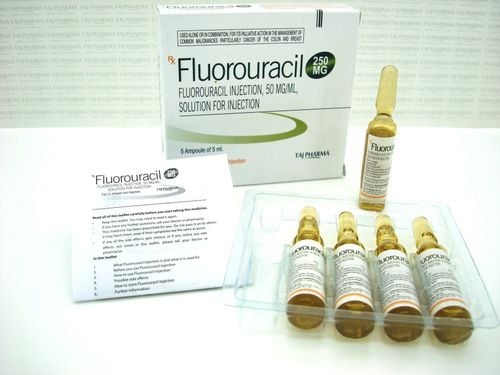This is an automatically translated article.
Doxekal 20mg and 80mg drugs have the main ingredient Docetaxel, which belongs to the taxoid group of cancer drugs. Doxekal drugs are commonly used in the treatment of cancers such as head and neck cancer, breast cancer, lung cancer, stomach cancer... Learn basic information about ingredients, drug uses, Dosage and side effects of Doxekal will help patients improve the effectiveness of treatment.
1. What is Doxekal?
Doxekal drug is prepared as a concentrated injection with two types, Doxekal 20mg and Doxekal 80mg, with main ingredients including:
Doxekal 20mg/0.5 ml:
Active ingredient: Docetaxel (anhydrous) content 20 mg /0.5 ml. 1.5 ml solvent vial: Ethanol Anhydrous, 1.5 ml distilled water for injection. Doxekal 80mg/2 ml:
Active ingredient: Docetaxel (anhydrous) 80 mg/2 ml. Solvent vial 6 ml: Ethanol Anhydrous, distilled water for injection just enough 6 ml. Docetaxel is an active anti-mitotic agent that inhibits cell division through binding to the Beta subunit of free Tubulins, promotes Tubulin polymerization of stable tubular microstructures, and inhibits dissociation. Removes tubular microstructures leading to inhibition of mitotic and interphase processes.
Docetaxel does not change the number of fibroblasts in the microtubules associated with paclitaxel or other cytotoxic agents used in cancer treatment.
2. What does Doxekal do?
Doxekal is indicated for the treatment of advanced or metastatic cancers such as:
Breast cancer Non-small cell lung cancer Ovarian cancer Prostate cancer Stomach cancer Head and neck cancer
3. Contraindications of the drug Doxekal
In the following cases, the drug Doxekal is not allowed to prescribe:
Hypersensitivity to any ingredient of the drug Doxekal. History of allergy to other drugs containing the active ingredient Docetaxel. Severe liver and kidney dysfunction. Bone marrow depression with neutrophil counts < 1,500 cells/mm3 and platelet counts < 100,000 cells/mm3. Alcoholics. People with chickenpox or Herpes zoster infection are at risk of severe complications. People with a history or current pleural effusion. Women who are pregnant or breastfeeding. Children < 16 years old.
4. Dosage and how to use Doxekal
4.1. Dosage: Breast cancer
Monotherapy dose: Infusion of 100 mg/m2 skin over 1 hour every 3 weeks. Combination dose: Infusion 75 mg/m2 skin in combination with doxorubicin 50 mg/m2 skin. Non-small cell lung cancer
Dose for subjects not receiving chemotherapy: Infusion of 75 mg/m2 skin over 1 hour every 3 weeks, combined with Cisplatin 75 mg/m2 skin over 30-60 minutes. Dose for subjects not responding to chemotherapy: 75 mg/m2 skin infusion over 1 hour every 3 weeks. Ovarian cancer
Monotherapy dose: 100 mg/m2 skin infusion over 1 hour every 3 weeks. Prostate cancer
Dose: Infusion 75 mg/m2 skin for 1 hour every 3 weeks, combined with oral Prednisone 5 mg x 2 times/day. Gastric carcinoma
Dose: Infuse 75 mg/m2 skin over 1 hour every 3 weeks, in combination with Cisplatin 75 mg/m2 skin over 1-3 hours on the first day. For the next five days, 5-Fluorouacil 750 mg/m2 skin infusion was continued for 24 hours. Cancer of the head and neck
Dose: 75 mg/m2 skin infusion over 1 hour every 3 weeks, in combination with Cisplatin 75 mg/m2 skin over 1 hour on the first day. For the next five days, 5-Fluorouacil 750 mg/m2 skin infusion was continued for 24 hours. Treatment for 4 cycles. 4.2. Recommendations for use The use of Doxekal should be carried out in a hospital setting and under the supervision of an oncologist. Use a course of oral corticosteroids before using Doxekal. Doxekal is for intravenous use and needs to be diluted before use. Reduce the dose of Doxekal and its combination in patients who experience adverse events or develop impaired liver-renal function.
5. Side effects encountered when using Doxekal
Doxekal treatment with high dose or long term, may cause side effects such as:
Common: Bacterial infection, anemia or leukopenia and thrombocytopenia, fever, allergies. Numbness, stinging or pain in the muscles and joints. Headache, insomnia. Eye inflammation or increased tear production. Swelling due to abnormal lymphatic drainage. Shortness of breath, runny nose, cough, inflammation of the nose and throat, nosebleeds. Ulcers in the mouth, loss of appetite, change in taste, digestive disorders... Uncommon: Oral candidiasis, dehydration, dizziness, loss of hearing. Low blood pressure, fast or irregular heartbeat, heart failure. Esophagitis, dry mouth, difficulty swallowing or pain when swallowing. Increase liver enzymes. Shortness of breath, shortness of breath, tightness in the chest, or wheezing. Urticaria, generalized red skin rash, severe can lead to anaphylaxis. The side effects after using Doxekal are varied and difficult to control. Therefore, doctors should stop taking Doxekal immediately after detecting the above side effects or other abnormalities. When family members and patients detect abnormalities after taking Doxekal, they should promptly notify the treating doctor or immediately go to the medical examination and treatment facility for timely treatment.
6. Note the use of Doxekal in the following subjects
Care should be taken, dose reduction and close monitoring when deciding to use Doxekal in the elderly, patients with severe neutropenia or thrombocytopenia, and people with impaired liver and kidney function.
Pregnant women: The US Food and Drug Administration (FDA) classifies Doxekal as a class D drug, which is definitely a risk to the fetus. Therefore, it is not recommended to use Doxekal in pregnant women, especially during the first trimester..
Lactating women : There are no reliable data regarding the distribution of Doxekal in the human body. breast milk, therefore, Doxekal should not be used in these subjects.
7. Doxekal drug interactions
Interactions with other drugs
The combined use of Doxekal and drugs that cause hematopoietic disorders increases the side effects of Doxekal's leukopenia and thrombocytopenia. Concomitant use of Doxekal and other myelosuppressive agents or other radiation therapy may increase bone marrow suppression. Concomitant use of Doxekal with the following drugs may impair liver function: Erythromycin, Ketoconazole, Midazolam, Orphenadrine, Testosterone Doxekal metabolism inhibitors: Troleandomycin, Azathioprine, Chlorambucil, Glucocorticoids Combination use of Doxekal and Tacrolimus increases the risk of infection. The combined use of Doxekal and Inactivated Virus Vaccine may reduce the patient's antibody response to the vaccine, thereby reducing the effectiveness of the vaccine. The combined use of Doxekal and a live virus vaccine increases the replication of the virus, thereby increasing the undesirable effects of the vaccine. In addition, Doxekal reduces the patient's antibody response to the vaccine, thereby reducing the effectiveness of the vaccine. Above is basic information about the ingredients, uses, dosage and unwanted side effects when using Doxekal medicine. The best treatment for cancer patients with Doxekal requires close cooperation between the patient, family and oncologist.
Please dial HOTLINE for more information or register for an appointment HERE. Download MyVinmec app to make appointments faster and to manage your bookings easily.













